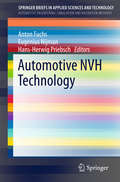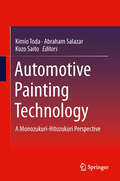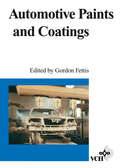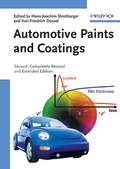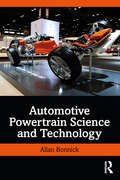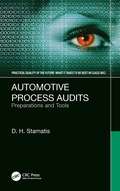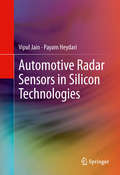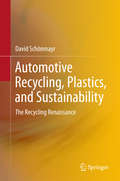- Table View
- List View
Automotive Manufacturing Processes: A Case Study Approach
by G.K. Awari V.S. Kumbhar R.B. Tirpude S.W. RajurkarAutomotive Manufacturing Processes discusses basic principles and operational procedures of automotive manufacturing processes, issues in the automotive industry like material selection, and troubleshooting. Every chapter includes specific learning objectives, multiple-choice questions to test conceptual understanding of the subject and put theory into practice, review questions, solved problems, and unsolved exercises. It covers important topics including material decision-making processes, surface hardening processes, heat treatment processes, effects of friction and velocity distribution, the metallurgical spectrum of forging, and surface finishing processes. Features: Discusses automotive manufacturing processes in a comprehensive manner with the help of applications. Provides case studies addressing issues in the automotive industry and manufacturing operations in the production of vehicles. Discussion on material properties while laying emphasis on the materials and processing parameters. Covers applications and case studies of the automotive industry. The text will be useful for senior undergraduates, graduate students and academic researchers in areas including automobile engineering, industrial and manufacturing engineering and mechanical engineering.
Automotive Manufacturing Processes: A Case Study Approach
by G.K. Awari V.S. Kumbhar R.B. Tirpude S.W. RajurkarAutomotive Manufacturing Processes discusses basic principles and operational procedures of automotive manufacturing processes, issues in the automotive industry like material selection, and troubleshooting. Every chapter includes specific learning objectives, multiple-choice questions to test conceptual understanding of the subject and put theory into practice, review questions, solved problems, and unsolved exercises. It covers important topics including material decision-making processes, surface hardening processes, heat treatment processes, effects of friction and velocity distribution, the metallurgical spectrum of forging, and surface finishing processes. Features: Discusses automotive manufacturing processes in a comprehensive manner with the help of applications. Provides case studies addressing issues in the automotive industry and manufacturing operations in the production of vehicles. Discussion on material properties while laying emphasis on the materials and processing parameters. Covers applications and case studies of the automotive industry. The text will be useful for senior undergraduates, graduate students and academic researchers in areas including automobile engineering, industrial and manufacturing engineering and mechanical engineering.
Automotive, Mechanical and Electrical Engineering: Proceedings of the 2016 International Conference on Automotive Engineering, Mechanical and Electrical Engineering (AEMEE 2016), Hong Kong, China, December 9-11, 2016
by Lin LiuThe 2016 International Conference on Automotive Engineering, Mechanical and Electrical Engineering (AEMEE 2016) was held December 9-11, 2016 in Hong Kong, China. AEMEE 2016 was a platform for presenting excellent results and new challenges facing the fields of automotive, mechanical and electrical engineering. Automotive, Mechanical and Electrical Engineering brings together a wide range of contributions from industry and governmental experts and academics, experienced in engineering, design and research. Papers have been categorized under the following headings: Automotive Engineering and Rail Transit Engineering. Mechanical, Manufacturing, Process Engineering. Network, Communications and Applied Information Technologies. Technologies in Energy and Power, Cell, Engines, Generators, Electric Vehicles. System Test and Diagnosis, Monitoring and Identification, Video and Image Processing. Applied and Computational Mathematics, Methods, Algorithms and Optimization. Technologies in Electrical and Electronic, Control and Automation. Industrial Production, Manufacturing, Management and Logistics.
Automotive, Mechanical and Electrical Engineering: Proceedings of the 2016 International Conference on Automotive Engineering, Mechanical and Electrical Engineering (AEMEE 2016), Hong Kong, China, December 9-11, 2016
by Lin LiuThe 2016 International Conference on Automotive Engineering, Mechanical and Electrical Engineering (AEMEE 2016) was held December 9-11, 2016 in Hong Kong, China. AEMEE 2016 was a platform for presenting excellent results and new challenges facing the fields of automotive, mechanical and electrical engineering. Automotive, Mechanical and Electrical Engineering brings together a wide range of contributions from industry and governmental experts and academics, experienced in engineering, design and research. Papers have been categorized under the following headings: Automotive Engineering and Rail Transit Engineering. Mechanical, Manufacturing, Process Engineering. Network, Communications and Applied Information Technologies. Technologies in Energy and Power, Cell, Engines, Generators, Electric Vehicles. System Test and Diagnosis, Monitoring and Identification, Video and Image Processing. Applied and Computational Mathematics, Methods, Algorithms and Optimization. Technologies in Electrical and Electronic, Control and Automation. Industrial Production, Manufacturing, Management and Logistics.
Automotive Mechatronics: Volume II (Intelligent Systems, Control and Automation: Science and Engineering #52)
by B. T. FijalkowskiThis book presents operational and practical issues of automotive mechatronics with special emphasis on the heterogeneous automotive vehicle systems approach, and is intended as a graduate text as well as a reference for scientists and engineers involved in the design of automotive mechatronic control systems.As the complexity of automotive vehicles increases, so does the dearth of high competence, multi-disciplined automotive scientists and engineers. This book provides a discussion into the type of mechatronic control systems found in modern vehicles and the skills required by automotive scientists and engineers working in this environment. Divided into two volumes and five parts, Automotive Mechatronics aims at improving automotive mechatronics education and emphasises the training of students’ experimental hands-on abilities, stimulating and promoting experience among high education institutes and produce more automotive mechatronics and automation engineers. The main subject that are treated are: VOLUME I: RBW or XBW unibody or chassis-motion mechatronic control hypersystems; DBW AWD propulsion mechatronic control systems; BBW AWB dispulsion mechatronic control systems;VOLUME II: SBW AWS conversion mechatronic control systems; ABW AWA suspension mechatronic control systems.This volume was developed for undergraduate and postgraduate students as well as for professionals involved in all disciplines related to the design or research and development of automotive vehicle dynamics, powertrains, brakes, steering, and shock absorbers (dampers). Basic knowledge of college mathematics, college physics, and knowledge of the functionality of automotive vehicle basic propulsion, dispulsion, conversion and suspension systems is required.
Automotive Mechatronics: Volume I (Intelligent Systems, Control and Automation: Science and Engineering #47)
by B. T. FijalkowskiThis book presents operational and practical issues of automotive mechatronics with special emphasis on the heterogeneous automotive vehicle systems approach, and is intended as a graduate text as well as a reference for scientists and engineers involved in the design of automotive mechatronic control systems.As the complexity of automotive vehicles increases, so does the dearth of high competence, multi-disciplined automotive scientists and engineers. This book provides a discussion into the type of mechatronic control systems found in modern vehicles and the skills required by automotive scientists and engineers working in this environment. Divided into two volumes and five parts, Automotive Mechatronics aims at improving automotive mechatronics education and emphasises the training of students’ experimental hands-on abilities, stimulating and promoting experience among high education institutes and produce more automotive mechatronics and automation engineers. The main subject that are treated are: VOLUME I: RBW or XBW unibody or chassis-motion mechatronic control hypersystems; DBW AWD propulsion mechatronic control systems; BBW AWB dispulsion mechatronic control systems;VOLUME II: SBW AWS diversion mechatronic control systems; ABW AWA suspension mechatronic control systems.This volume was developed for undergraduate and postgraduate students as well as for professionals involved in all disciplines related to the design or research and development of automotive vehicle dynamics, powertrains, brakes, steering, and shock absorbers (dampers). Basic knowledge of college mathematics, college physics, and knowledge of the functionality of automotive vehicle basic propulsion, dispulsion, conversion and suspension systems is required.
Automotive Mechatronics: Automotive Networking, Driving Stability Systems, Electronics (Bosch Professional Automotive Information)
by Konrad ReifAs the complexity of automotive vehicles increases this book presents operational and practical issues of automotive mechatronics. It is a comprehensive introduction to controlled automotive systems and provides detailed information of sensors for travel, angle, engine speed, vehicle speed, acceleration, pressure, temperature, flow, gas concentration etc. The measurement principles of the different sensor groups are explained and examples to show the measurement principles applied in different types.
Automotive Model Predictive Control: Models, Methods and Applications (Lecture Notes in Control and Information Sciences #402)
by Frank Allgöwer Luigi Glielmo Carlos Guardiola Ilya Kolmanovsky Luigi Del ReAutomotive control has developed over the decades from an auxiliary te- nology to a key element without which the actual performances, emission, safety and consumption targets could not be met. Accordingly, automotive control has been increasing its authority and responsibility – at the price of complexity and di?cult tuning. The progressive evolution has been mainly ledby speci?capplicationsandshorttermtargets,withthe consequencethat automotive control is to a very large extent more heuristic than systematic. Product requirements are still increasing and new challenges are coming from potentially huge markets like India and China, and against this ba- ground there is wide consensus both in the industry and academia that the current state is not satisfactory. Model-based control could be an approach to improve performance while reducing development and tuning times and possibly costs. Model predictive control is a kind of model-based control design approach which has experienced a growing success since the middle of the 1980s for “slow” complex plants, in particular of the chemical and process industry. In the last decades, severaldevelopments haveallowedusing these methods also for “fast”systemsandthis hassupporteda growinginterestinitsusealsofor automotive applications, with several promising results reported. Still there is no consensus on whether model predictive control with its high requi- ments on model quality and on computational power is a sensible choice for automotive control.
Automotive NVH Technology (SpringerBriefs in Applied Sciences and Technology)
by Anton Fuchs Eugenius Nijman Hans-Herwig PriebschThis book presents seven chapters examining selected noise, vibration and harshness (NVH) topics that are highly relevant for automotive vehicle development. These include applications following the major trends toward increased passenger comfort, vehicle electrification and lightweight design. The authors of the seven chapters, all of which are experts from the automotive industry and academia, present the foremost challenges and potential solutions in this demanding field. Among others, applications for sound optimization in downsized engines, noise optimization in electric powertrains, weight reduction options for exhaust systems, porous materials description, and the vibro-acoustic analysis of geared systems are discussed.
Automotive Painting Technology: A Monozukuri-Hitozukuri Perspective
by Kimio Toda, Abraham Salazar and Kozo SaitoThis book offers unique and valuable contributions to the field. It offers breadth and inclusiveness. Most existing works on automotive painting cover only a single aspect of this complex topic, such as the chemistry of paint or paint booth technology. Monozukuri and Hitozukuri are Japanese terms that can be translated as “making things” and “developing people” but their implications in Japanese are richer and more complex than this minimal translation would indicate. The Monozukuri-Hitozukuri perspective is drawn from essential principles on which the Toyota approach to problem-solving and continuous improvement is based. From this perspective, neither painting technology R&D nor painting technology use in manufacturing can be done successfully without integrating technological and human concerns involved with making and learning in the broadest sense, as the hyphen is meant to indicate. The editors provide case studies and examples -- drawn from Mr. Toda’s 33 years of experience with automotive painting at Toyota and from Dr. Saito’s 18 years experience with IR4TD, the research-for-development group he leads at the University of Kentucky -- that give details on how these two principles can be integrated for successful problem-solving and innovation in industry, in university R&D, and in the collaboration between the two. The book will bring readers up to date on progress in the field over the last decade to provide a basis for and to indicate fruitful directions in future R&D and technology innovation for automotive painting.
Automotive Paints and Coatings
by Gordon FettisDedicated wholly to automotive coatings, this book is the first of its kind. It provides an in-depth coverage of the subject and in keeping with the international nature of the automotive business the book has a truly multinational flavour with authors selected from Australia, Japan, Europe and the USA. An authoritative and informative treatment of all aspects of coatings formulation are presented together with their manufacture and application. Numerous chapters written by experts in the field deal with substrate pretreatment, undercoats, surfacers and topcoats. Finishes for both metals and non-metallics are described as well as speciality coatings such as sealers, antichip and underbody paints. Further valuable information on commercial support for the sale of finishes in the automotive industry and the licensing of technology is also given. Specialists involved in a wide range of disciplines in the coatings industry including chemists, chemical engineers and commercial staff will find this up-to-date source of exceptional interest.
Automotive Paints and Coatings
by Hans-Joachim Streitberger Karl-Friedrich DosselNow in its second edition and still the only book of its kind, this is an authoritative treatment of all stages of the coating process -- from body materials, paint shop design, and pre-treatment, through primer surfacers and top coats. New topics of interest covered are color control, specification and testing of coatings, as well as quality and supply concepts, while valuable information on capital and legislation aspects is given. Invaluable for engineers in the automotive and paints and coatings industry as well as for students in the field.
Automotive Power Systems
by Dorin O. NeacșuVehicles are intrinsically linked to our lives. This book covers all technical details of the vehicle electrification process, with focus on power electronics. The main challenge in vehicle electrification consists of replacing the engine-based mechanical, pneumatic, or hydraulic ancillary energy sources with electrical energy processed through an electromagnetic device. The book illustrates this evolutionary process with numerous series-production examples for either of body or chassis systems, from old milestones to futuristic luxury vehicles. Electrification of ancillaries and electric propulsion eventually meet into an all-electric vehicle and both processes rely heavily on power electronics. Power electronics deals with electronic processing of electrical energy. This makes it a support technology for the automotive industry. All the automotive visions for the next decade (2020-2030) are built on top of power electronics and the automotive power electronics industry is expected at 15% compound annual growth rate, the highest among all automotive technologies. Hence, automotive power electronics industry is very appealing for recent and future graduates. The book structure follows the architecture of the electrical power system for a conventional engine-based vehicle, with a last chapter dedicated to an introduction onto electric propulsion. The first part of the book describes automotive technologies for generation and distribution of electrical power, as well as its usage within body systems, chassis systems, or lighting. The second part explores deeper into the specifics of each component of the vehicle electric power system. Since cars have been on the streets for over 100 years, each chapter starts with a list of historical achievements. Recognizing the engineering effort span over more than a century ennobles the R&D efforts of the new millennium. Focus on history of electricity in vehicle applications is another attractive treat of the book. The book fills a gap between books targeting practical education and works sharing advanced academic vision, offering students and academics a quick tour of the basic tools and long-standing infrastructure, and offering practicing engineers an introduction on newly introduced power electronics-based technologies. It is therefore recommended as a must-have book for students and early graduates in automotive power electronics activities.
Automotive Power Systems
by Dorin O. NeacșuVehicles are intrinsically linked to our lives. This book covers all technical details of the vehicle electrification process, with focus on power electronics. The main challenge in vehicle electrification consists of replacing the engine-based mechanical, pneumatic, or hydraulic ancillary energy sources with electrical energy processed through an electromagnetic device. The book illustrates this evolutionary process with numerous series-production examples for either of body or chassis systems, from old milestones to futuristic luxury vehicles. Electrification of ancillaries and electric propulsion eventually meet into an all-electric vehicle and both processes rely heavily on power electronics. Power electronics deals with electronic processing of electrical energy. This makes it a support technology for the automotive industry. All the automotive visions for the next decade (2020-2030) are built on top of power electronics and the automotive power electronics industry is expected at 15% compound annual growth rate, the highest among all automotive technologies. Hence, automotive power electronics industry is very appealing for recent and future graduates. The book structure follows the architecture of the electrical power system for a conventional engine-based vehicle, with a last chapter dedicated to an introduction onto electric propulsion. The first part of the book describes automotive technologies for generation and distribution of electrical power, as well as its usage within body systems, chassis systems, or lighting. The second part explores deeper into the specifics of each component of the vehicle electric power system. Since cars have been on the streets for over 100 years, each chapter starts with a list of historical achievements. Recognizing the engineering effort span over more than a century ennobles the R&D efforts of the new millennium. Focus on history of electricity in vehicle applications is another attractive treat of the book. The book fills a gap between books targeting practical education and works sharing advanced academic vision, offering students and academics a quick tour of the basic tools and long-standing infrastructure, and offering practicing engineers an introduction on newly introduced power electronics-based technologies. It is therefore recommended as a must-have book for students and early graduates in automotive power electronics activities.
Automotive Power Transmission Systems (Automotive Series)
by Yi Zhang Chris MiProvides technical details and developments for all automotive power transmission systems The transmission system of an automotive vehicle is the key to the dynamic performance, drivability and comfort, and fuel economy. Modern advanced transmission systems are the combination of mechanical, electrical and electronic subsystems. The development of transmission products requires the synergy of multi-disciplinary expertise in mechanical engineering, electrical engineering, and electronic and software engineering. Automotive Power Transmission Systems comprehensively covers various types of power transmission systems of ground vehicles, including conventional automobiles driven by internal combustion engines, and electric and hybrid vehicles. The book covers the technical aspects of design, analysis and control for manual transmissions, automatic transmission, CVTs, dual clutch transmissions, electric drives, and hybrid power systems. It not only presents the technical details of key transmission components, but also covers the system integration for dynamic analysis and control. Key features: Covers conventional automobiles as well as electric and hybrid vehicles. Covers aspects of design, analysis and control. Includes the most recent developments in the field of automotive power transmission systems. The book is essential reading for researchers and practitioners in automotive, mechanical and electrical engineering.
Automotive Power Transmission Systems (Automotive Series)
by Yi Zhang Chris MiProvides technical details and developments for all automotive power transmission systems The transmission system of an automotive vehicle is the key to the dynamic performance, drivability and comfort, and fuel economy. Modern advanced transmission systems are the combination of mechanical, electrical and electronic subsystems. The development of transmission products requires the synergy of multi-disciplinary expertise in mechanical engineering, electrical engineering, and electronic and software engineering. Automotive Power Transmission Systems comprehensively covers various types of power transmission systems of ground vehicles, including conventional automobiles driven by internal combustion engines, and electric and hybrid vehicles. The book covers the technical aspects of design, analysis and control for manual transmissions, automatic transmission, CVTs, dual clutch transmissions, electric drives, and hybrid power systems. It not only presents the technical details of key transmission components, but also covers the system integration for dynamic analysis and control. Key features: Covers conventional automobiles as well as electric and hybrid vehicles. Covers aspects of design, analysis and control. Includes the most recent developments in the field of automotive power transmission systems. The book is essential reading for researchers and practitioners in automotive, mechanical and electrical engineering.
Automotive Powertrain Science and Technology
by Allan BonnickA motor vehicle’s powertrain consists of the components which generate power and enable it to move – its engine, exhaust system, transmission, drive shaft, suspension and wheels. Any automotive engineering student going beyond basic mechanics will need a sound knowledge of the mathematics and scientific principles, particularly calculus and algebra, which underpin powertrain technology. This textbook supports a series of courses, for instance BTEC unit 28 “Further Mathematics for Engineering Technicians”, which is a requisite for a foundation degree in automotive engineering, and BTEC higher unit 25 “Engine and Vehicle Design and Performance”, without giving full coverage of automotive technology. It is a more focused companion to the author’s Automotive Science and Mathematics 978-0-7506-8522-1, also published by Routledge.
Automotive Powertrain Science and Technology
by Allan BonnickA motor vehicle’s powertrain consists of the components which generate power and enable it to move – its engine, exhaust system, transmission, drive shaft, suspension and wheels. Any automotive engineering student going beyond basic mechanics will need a sound knowledge of the mathematics and scientific principles, particularly calculus and algebra, which underpin powertrain technology. This textbook supports a series of courses, for instance BTEC unit 28 “Further Mathematics for Engineering Technicians”, which is a requisite for a foundation degree in automotive engineering, and BTEC higher unit 25 “Engine and Vehicle Design and Performance”, without giving full coverage of automotive technology. It is a more focused companion to the author’s Automotive Science and Mathematics 978-0-7506-8522-1, also published by Routledge.
Automotive Process Audits: Preparations and Tools (Practical Quality of the Future)
by D. H. StamatisWith a detailed discussion on the preparation and tools needed for an automotive process audit, this book addresses the fundamental issues and concerns by focusing on two objectives: explaining the methods and tools used in the process for the organization, and provide a reference or manual for dealing with documenting quality issues. This book addresses the fundamental issues and concerns for a successful automotive process audit and details specifically how to prepare for it. It presents a complete assessment of what an organization must do to earn certification in ISO standards, industry standards, and customer-specific requirements. It also focuses on the efficiency of resources within an organization so that an audit can be successful and describes the methodologies to optimize the process by knowing what to do, what to say, and how to prove it. A road map is offered for the "process audit" and the "layered audit," and defines a clear distinction between the preparation details for each. This book is intended for those that conduct audits, those who are interested in auditing, and those who are being audited. It specifically addresses how to prepare for an automotive process audit for readers who are involved in quality, manufacturing, and operations management, and those who work with suppliers.
Automotive Process Audits: Preparations and Tools (Practical Quality of the Future)
by D. H. StamatisWith a detailed discussion on the preparation and tools needed for an automotive process audit, this book addresses the fundamental issues and concerns by focusing on two objectives: explaining the methods and tools used in the process for the organization, and provide a reference or manual for dealing with documenting quality issues. This book addresses the fundamental issues and concerns for a successful automotive process audit and details specifically how to prepare for it. It presents a complete assessment of what an organization must do to earn certification in ISO standards, industry standards, and customer-specific requirements. It also focuses on the efficiency of resources within an organization so that an audit can be successful and describes the methodologies to optimize the process by knowing what to do, what to say, and how to prove it. A road map is offered for the "process audit" and the "layered audit," and defines a clear distinction between the preparation details for each. This book is intended for those that conduct audits, those who are interested in auditing, and those who are being audited. It specifically addresses how to prepare for an automotive process audit for readers who are involved in quality, manufacturing, and operations management, and those who work with suppliers.
Automotive Product Development: A Systems Engineering Implementation
by Vivek D. BhiseThis book is about how to develop future automotive products by applying the latest methodologies based on a systems engineering approach and by taking into account many issues facing the auto industry such as meeting government safety, emissions and fuel economy regulations, incorporating advances in new technology applications in structural materials, power trains, vehicle lighting systems, displays and telematics, and satisfying the very demanding customer. It is financially disastrous for any automotive company to create a vehicle that very few people want. To design an automotive product that will be successful in the marketplace requires carefully orchestrated teamwork of experts from many disciplines, substantial amount of resources, and application of proven techniques at the right time during the product development process. Automotive Product Development: A Systems Engineering Implementation is intended for company management personnel and graduate students in engineering, business management and other disciplines associated with the development of automotive and other complex products.
Automotive Product Development: A Systems Engineering Implementation
by Vivek D. BhiseThis book is about how to develop future automotive products by applying the latest methodologies based on a systems engineering approach and by taking into account many issues facing the auto industry such as meeting government safety, emissions and fuel economy regulations, incorporating advances in new technology applications in structural materials, power trains, vehicle lighting systems, displays and telematics, and satisfying the very demanding customer. It is financially disastrous for any automotive company to create a vehicle that very few people want. To design an automotive product that will be successful in the marketplace requires carefully orchestrated teamwork of experts from many disciplines, substantial amount of resources, and application of proven techniques at the right time during the product development process. Automotive Product Development: A Systems Engineering Implementation is intended for company management personnel and graduate students in engineering, business management and other disciplines associated with the development of automotive and other complex products.
Automotive Production Systems and Standardisation: From Ford to the Case of Mercedes-Benz (Contributions to Management Science)
by Constanze ClarkeIn January 2000, Mercedes-Benz started to implement the Mercedes-Benz Prod- tion System (MPS) throughout its world-wide passenger car plants. This event is exemplary of a trend within the automotive industry: the creation and introduction of company-specific standardised production systems. It gradually emerged with the introduction of the Chrysler Operating System (COS) in the mid-1990s and represents a distinct step in the process towards implementing the universal pr- ciples of lean thinking as propagated by the MIT-study. For the academic field of industrial sociology and labour policy, the emergence of this trend seems to mark a new stage in the evolution of the debate about production systems in the auto- tive industry (Jürgens 2002:2), particularly as it seems to undermine the stand of the critics of the one-best way model (Boyer and Freyssenet 1995). The introduction of company-level standardised production systems marks the starting point of the present study. At the core of it is a case study about the M- cedes Benz Production System (MPS).
Automotive Radar Sensors in Silicon Technologies
by Vipul Jain Payam HeydariOne of the leading causes of automobile accidents is the slow reaction of the driver while responding to a hazardous situation. State-of-the-art wireless electronics can automate several driving functions, leading to significant reduction in human error and improvement in vehicle safety. With continuous transistor scaling, silicon fabrication technology now has the potential to substantially reduce the cost of automotive radar sensors. This book bridges an existing gap between information available on dependable system/architecture design and circuit design. It provides the background of the field and detailed description of recent research and development of silicon-based radar sensors. System-level requirements and circuit topologies for radar transceivers are described in detail. Holistic approaches towards designing radar sensors are validated with several examples of highly-integrated radar ICs in silicon technologies. Circuit techniques to design millimeter-wave circuits in silicon technologies are discussed in depth.
Automotive Recycling, Plastics, and Sustainability: The Recycling Renaissance
by David SchönmayrThis book provides transdisciplinary analyses of the automotive plastics production and recycling system, including prognoses, scenarios and solutions for corporate sustainability management.A book on plastics, not written by a plastics guy. But a sustainability guy. Plastics schizophrenia and the automotive abyss: The industry is facing a severe challenge. It is the inevitable and promising change towards a sustainable economy. However, the automotive industry is primarily concerned with the CO2 emissions from cars when driving, while the rise of lightweight plastics, electric drive and heavy batteries make the production and end-of-life phase ever more important. Therefore, the currently increasing use of non-sustainable virgin plastics in cars has to be tackled.The plastics and the automotive industry now have a chance, and this chance is the Recycling Renaissance.This book offers:• Holistic and transdisciplinary overview on sustainability and automotive plastics from all angles including economy, ecology, technology, and politics with a focus on Europe• Concise analyses, prognoses, tools and a roadmap with solutions for companies, developed together with international experts from industry and academia • Strong scientific basis and independent research including a Europe-wide survey, expert interviews, and workshops• More than 80 illustrations and 15 tables including a SCOT analysis • Executive summaries after each chapter for fast reading“The uniqueness of this book lies within the different point of view on this topic from a critical, outstanding scientist.” - Univ.-Prof. Dipl.-Ing. Dr.mont. Pomberger, Montanuni Leoben






